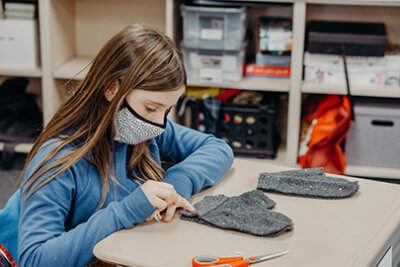December 17, 2020
 by Dr. Bill Hudson, Head of School
by Dr. Bill Hudson, Head of School
In a few short days, the winter solstice will be upon us. Literally and figuratively—a few short days. Monday will be the shortest day of the year, the longest night, and the first official day of winter. The increasing darkness over the last several months has resulted in six additional hours of nighttime. Darkness seems to have also crept into our psyche as we experience the impact and uncertainty of the pandemic, the economy, and the social and political discord. A long winter break is needed now more than ever.
The heaviness of the dark is coupled with what seems to be more anxiety, more stress, more work, and less time to unwind. It has been proven that we have more time for leisure than we did 50 years ago, and it doesn’t seem to be any more relaxing, in part because of the pandemic, the fuzzy line between home and work, and the disintermediating effects of our screens. According to behavioral scientist Ashley Whillans, emails, texts, and social media aren’t just eating 10% of our free time—they’re fragmenting it into tiny pieces of “confetti” that we can’t enjoy. Whillans recommends blocking out uninterrupted time for leisure, just as we do for deep work. (You might enjoy Whillans’ article “Time Confetti and the Broken Promise of Leisure.”)
Like the quiet of a snowfall, winter break affords an opportunity to be silent and reflect on what matters most and makes our lives meaningful. Minnesota culture, with its deep Scandinavian roots, urges us to embrace winter to overcome the darkness and gloom. The Danes call this “hygge” a term that has become popularized (although Norwegians claim its origins.) Regardless of the debate, hygge looks to light, warmth, the outdoors, rest, comfort as antidotes to the cold and darkness and the sources of joy and growth. Whether it is lighting candles, adding more holiday lights, turning up the thermostat, lounging about all day in pajamas, or taking long winter hikes, hygge presents a pathway to self-care.
Not to be outdone by their neighbors, the Dutch offer concept “niksen”. Quite literally, niksen means to do nothing, to be idle or doing something without any use. Examples might be sitting quietly in a chair or looking out the window. Whereas mindfulness is about being present in the moment, niksen is more about carving out time to just be, even letting your mind wander rather than focusing on the details of an action.
There is quite a bit of practical wisdom for schools to break for several weeks at this time of year. Aside from celebrating some religious holidays, students, teachers, and staff all benefit from a slower pace, time to rest, relax, and rejuvenate. Whether it is hygge or niksen or your own tradition, I hope you too are able to disconnect from your work and reconnect to what matters most to you.
As I look back over the last year, I am filled with gratitude to have walked alongside of you. In the midst of darkness, your children have brought much light and burned bright when we all needed it most. Happy holidays and I look forward to the year ahead.